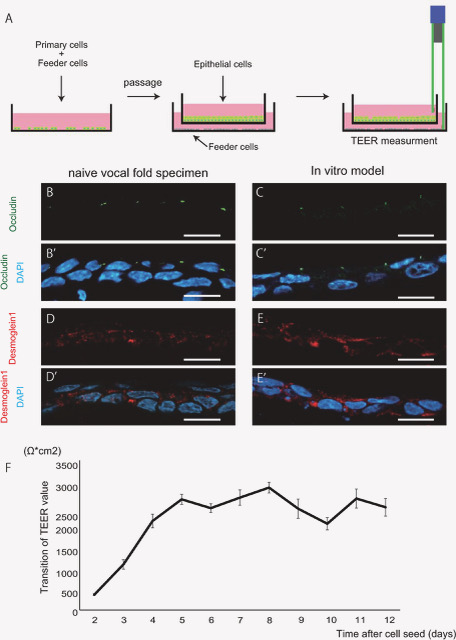Otolaryngology–Head and Neck Surgery treats various disorders. Our research focuses on sensory organs (auditory, vestibular, olfactory, gustatory) and aero digestive organs (respiration, swallowing, speech), which are essential for communication and life functions. We research sensorineural hearing loss treatments, including regenerating sensory cells and the eardrum, as well as inner ear drug delivery systems (DDS). For laryngotracheal regeneration, we developed artificial trachea and conducted an investigator initiated clinical trial for practical application of artificial trachea. We also conduct airway regeneration using iPS cell-derived ciliary cells and chondrocytes.
Research and Education
■ Inner Ear Regeneration and Auditory Central Nervous System Research Group
In mammals, once the inner ear is damaged after birth, auditory and vestibular functions rarely recover, leaving many patients suffering from sensorineural hearing loss or balance disorders. Our group aims to achieve functional regeneration of the inner ear by elucidating the mechanisms of inner ear development and regeneration, and by developing novel therapies for inner ear diseases1)2). In addition, hearing loss is known to affect brain functions related to communication. We are conducting a variety of clinical studies to clarify how hearing loss alters brain function, with the goal of contributing to more effective treatment strategies.
 Protective effect of IGF1 for outer hair cells against cisplatin. A–B. Representative image of the cochlear explants treated with 10 µM cisplatin (Cis) (A) or Cis and 5 µg/ml IGF1 (B) and stained for myosin7a (Myo7a, red) and actin filaments (phalloidin, green).
Protective effect of IGF1 for outer hair cells against cisplatin. A–B. Representative image of the cochlear explants treated with 10 µM cisplatin (Cis) (A) or Cis and 5 µg/ml IGF1 (B) and stained for myosin7a (Myo7a, red) and actin filaments (phalloidin, green).
■Head and Neck Research Group
Injury to the larynx or trachea can cause hoarseness and respiratory distress, so we are developing tissue‑engineering therapies to restore function. We have achieved structural regeneration using human iPS cells and artificial tracheal constructs, and we are investigating injury mechanisms and developing treatments to regenerate functional tracheal mucosa3)4). We also perform AI‑based voice analysis5) and create 3D‑printed models for anatomical education. Through cross‑laboratory collaborations, we aim to generate novel insights.
 A) Schematic of rat vocal fold epithelial cell culture. B) Immunostaining of intercellular adhesion molecules in cultured epithelium. C) Transepithelial electrical resistance (TEER) of cultured epithelium.
A) Schematic of rat vocal fold epithelial cell culture. B) Immunostaining of intercellular adhesion molecules in cultured epithelium. C) Transepithelial electrical resistance (TEER) of cultured epithelium.
Recent Publications
- Kagoshima H, Ohnishi H, Yamamoto R, Yasumoto A, Tona Y, Nakagawa T, Omori K, Yamamoto N. EBF1 Limits the Numbers of Cochlear Hair and Supporting Cells and Forms the Scala Tympani and Spiral Limbus during Inner Ear Development. J Neurosci. 2024 Feb 14;44(7):e1060232023.
- Yamahara K, Ohnishi H, Nakagawa T, Omori K, Yamamoto N. Insulin-like growth factor 1 protects cochlear outer cells against cisplatin. Hearing Research. 2025 Apr 23:463:109287.
- Kojima K, Katsuno T, Kishimoto Y, Mizuta M, Nakamura R, Ohnish H, Yamada K, Kawai Y, Tateya I, Omori K. In Vitro Model to Evaluate Effect of Acidic Pepsin on Vocal Fold Barrier Function. Biochem Biophys Res Commun. 2024 Nov 5:732:150401.
- Mizuno K, Ohnishi H, Kishimoto Y, Okuyama H, Kawai Y, Kitano M, Hayashi Y, Omori K. Transplantation of Human Induced Pluripotent Stem Cell-Derived Airway Epithelia at Different Induction Stages into Nude Rat. Cell Reprogram. 2024 Dec;26(6):156-163.
- Hasebe K, Fujimura S, Kojima T, Tamura K, Kawai Y, Kishimoto Y, Omori K. The Effect of Noise on Deep Learning for Classification of Pathological Voice. Laryngoscope. 2024 Aug;134(8):3537-3541.
Otolaryngology-Head and Neck Surgery
Associate Professor: Yo Kishimoto
Program-Specific Associate Professor: Atsushi Suehiro, Keigo Honda
Junior Associate Professor: Tsuyoshi Kojima, Koji Nishimura, Hiroshi Yamazaki
Program-Specific Junior Associate Professor: Hiroe Ohnishi
Assistant Professor: Yosuke Tona, Yoshitaka Kawai, Shintaro Fujimura, Mami Matsunaga, Ken Iwanaga, Yasuharu Haku, Akira Yoshizawa
Program-Specific Assistant Professor: Shinji Kaba, Atsushi Taguchi
TEL: +81-75-751-3346
FAX: +81-75-751-7225
e-mail :inq@ent.kuhp.kyoto-u.ac.jp
URL :https://ent.kuhp.kyoto-u.ac.jp/en/
